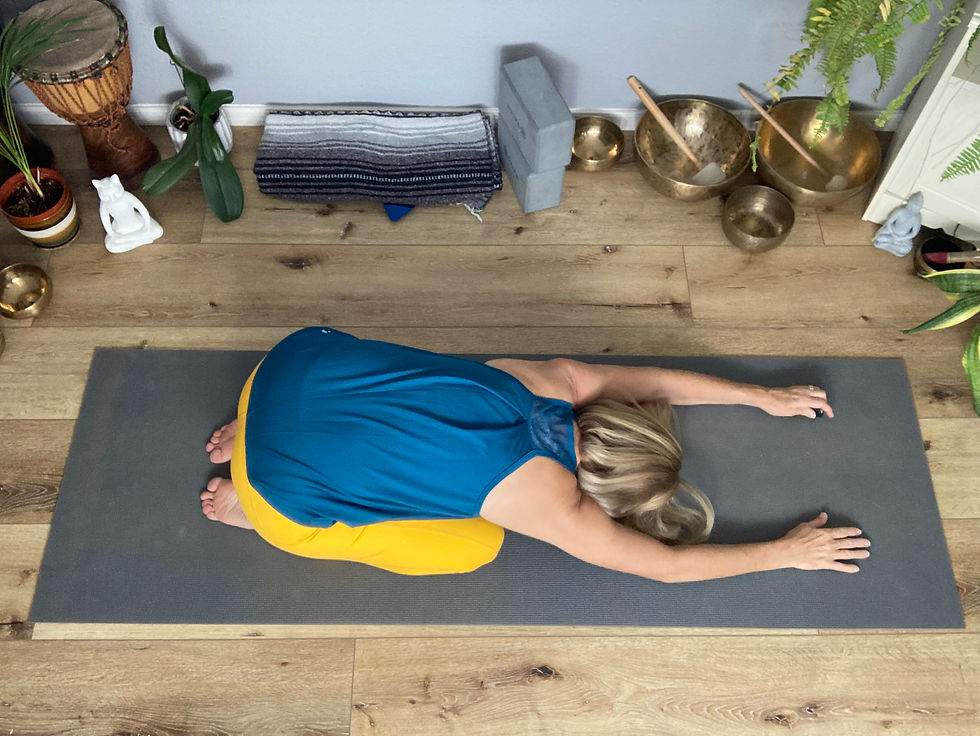Self-Love in Motion: Gentle Yoga for Valentine’s Day
- Jackie Paunil
- Feb 6
- 3 min read
Written by Jackie Paunil, Creator of the Young Heart Yoga App, E-RYT, RPYT, CHC, MFA
Empowering older adults to move, breathe, and thrive with grace and vitality.

Valentine’s Day—flowers, chocolates, and, oh yes, self-love! This year, let’s rewrite the narrative. Instead of reserving all that TLC for others, how about celebrating you? Self-love isn’t selfish; it’s foundational, especially as we age. Nurturing ourselves makes room for deeper, healthier connections with others. Yoga, with its ability to bridge body, mind, and spirit, is the perfect tool to cultivate self-care and self-compassion.
The Benefits of Yoga for Self-Love
Yoga does more than improve flexibility—it transforms how we relate to ourselves. Here’s how:
Boosts Self-Compassion
Yoga invites kindness and patience toward ourselves, whether we’re nailing a pose or wobbling like a flamingo in the wind. Studies confirm that practices like loving-kindness meditation can enhance self-compassion (Hofmann et al., 2011).
Improves Body Awareness
Forget the mirror’s critique; yoga is about tuning into your body’s abilities. From balancing in Tree Pose to stretching in a simple Child’s Pose, you’ll cultivate gratitude for what your body can do (Woodyard, 2011).
Reduces Stress
Gentle yoga and mindfulness help release physical tension and emotional clutter. Deep breaths and purposeful movement can turn a hectic day into a calming mini-retreat (Ross & Thomas, 2010).
Gentle Yoga Poses for Self-Care
Ready to nurture yourself? Try this easy routine, perfect for seniors and beginners:
Child’s Pose (Balasana) Sink into the floor, stretch your arms out, and let tension melt away. Breathe deeply and focus on the present moment.

Heart-Opening Pose (Supported Fish Pose) Using a bolster or pillow under your upper back, let your chest expand. This encourages openness and invites compassion to flow.

Seated Forward Fold (Paschimottanasana) Gently reach for your toes, or just rest your hands on your knees. It’s less about flexibility and more about grounding and introspection.

Savasana with Affirmations Lie down, close your eyes, and repeat affirmations like “I am worthy of love” or “I honor myself.” Resting is its own kind of self-care.

Practical Tips for Cultivating Self-Love Through Yoga
Approach each pose without judgment—progress, not perfection, is the goal.
Set an intention before starting, like gratitude or kindness.
Make yoga a habit. Even 10 minutes a day can work wonders for body and soul.
Make Yourself a Priority
This Valentine’s Day, give yourself the gift of care, compassion, and connection. Want more guided routines designed for gentle self-care? Download the Young Heart Yoga App. It’s your companion for nurturing body and mind at your own pace—because self-love never goes out of style.
About the Author

Jackie Paunil is a published author, wellness advocate, and creator of the Young Heart Yoga App, designed for active and older adults seeking balance, vitality, and mindfulness. With certifications including E-RYT, RPYT, CHC, and an MFA, Jackie combines her extensive training and life experience to inspire others to live with purpose and wellness.
Residing on a ranch in Casa Grande, Arizona, Jackie leads an organic lifestyle surrounded by animals she adores. She is a devoted wife, mother, proud “GiGi” to her grandchildren, and a world traveler who has explored the depths as a master scuba diver. Her in-person yoga and meditation classes, alongside her app, reflect her passion for helping others thrive. Jackie's teaching philosophy is grounded in her own holistic practices, empowering students to embrace sustainable, joyful movement and mindfulness for a more vibrant life.
References
Hofmann, S. G., Grossman, P., & Hinton, D. E. (2011). Loving-kindness and compassion meditation: Potential for psychological interventions. Clinical Psychology Review, 31(7), 1126–1132. https://doi.org/10.1016/j.cpr.2011.07.003
Woodyard, C. (2011). Exploring the therapeutic effects of yoga and its ability to increase quality of life. International Journal of Yoga, 4(2), 49–54. https://doi.org/10.4103/0973-6131.85485
Ross, A., & Thomas, S. (2010). The health benefits of yoga and exercise: A review of comparison studies. The Journal of Alternative and Complementary Medicine, 16(1), 3–12. https://doi.org/10.1089/acm.2009.0044
.png)
Comments